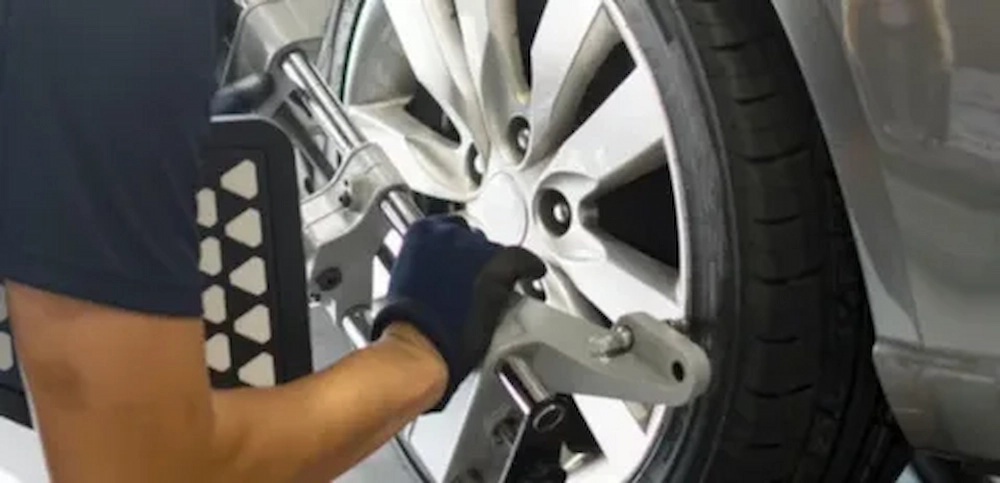
Why Wheel Alignment Matters
Wheel alignment ensures that your tires meet the road at the proper angle, keeping your vehicle stable and safe. Misalignment can cause uneven tire wear, reduced fuel efficiency, and extra strain on suspension components. After a collision, alignment checks are especially important, since impacts often create hidden structural damage in cars that throw off suspension geometry.
Working with an OEM-certified collision repair center ensures alignment is measured and corrected according to manufacturer standards.
How Often to Get Wheel Alignment
If your car has recently been in an accident, it’s wise to pair an alignment check with a frame straightening and repair service to ensure the underlying structure hasn’t shifted.
Most experts recommend scheduling service every 12,000–15,000 miles or once a year. However, this can vary depending on:
- Driving habits (frequent potholes, curbs, or rough roads).
- Vehicle type (performance or aluminum-bodied cars are more sensitive to impacts).
- Any recent collisions, even low-speed impacts.
Signs You Need Wheel Alignment
Even if you follow the recommended wheel alignment schedule, unexpected road conditions or minor collisions can throw your alignment out of spec sooner than expected. That’s why it’s important to recognize the signs you need wheel alignment before they create bigger problems.
- Car pulling to one side while driving – If you let go of the steering wheel and the car drifts left or right instead of continuing straight, chances are your wheels aren’t aligned correctly. This constant pull also puts extra stress on steering components.
- Steering wheel off-center even when driving straight – A crooked wheel is one of the most obvious car frame misalignment signs. Even after you’ve adjusted the steering, it will return off-center until alignment is corrected.
- Uneven or rapid tire wear – Misalignment causes one edge of the tires to wear down faster than the other. Left unchecked, you may need to replace tires long before their normal lifespan. This is why alignment is one of the most effective steps for uneven tire wear prevention.
- Vibrations at higher speeds – While vibrations can also result from unbalanced tires, persistent shaking in the steering wheel often indicates your wheels are not tracking straight. This not only affects comfort but also long-term suspension health.
- Difficulty controlling the vehicle in turns – If the car feels unstable or requires more effort to handle curves, it could be due to improper alignment angles. Over time, this can make everyday driving less safe and more tiring.
Recognizing these symptoms early is critical. Misalignment doesn’t just affect tire life — it may also be a sign of deeper issues like bent suspension arms or structural shifts after a collision. In such cases, scheduling a professional frame straightening and repair service is essential to restore both alignment and safety.
Benefits of Regular Wheel Alignment
The benefits of regular wheel alignment go far beyond smoother driving. Alignment is one of those maintenance steps that protects both safety and long-term value. Consistent service ensures your car handles as designed and prevents many hidden problems from developing.
- Uneven tire wear prevention – Misaligned wheels place uneven pressure on tire tread. This causes some areas to wear faster, often leading to bald spots or noisy vibrations. By keeping alignment in check, you extend tire life and avoid the cost of premature replacements.
- Improved fuel efficiency – When wheels are out of alignment, they create rolling resistance, forcing your engine to work harder. Even a small misalignment can reduce miles per gallon significantly. Keeping your wheels aligned means your car rolls straighter, saving you money at the pump.
- Safer handling and stability – Proper alignment ensures all four wheels track in the same direction. This makes your car more predictable during sudden lane changes, tight turns, or emergency maneuvers. It’s especially critical at higher speeds, where instability can quickly become dangerous.
- Less strain on suspension and steering – Suspension parts, ball joints, tie rods, and steering components are all designed to operate at specific angles. Misalignment stresses these systems and shortens their lifespan. Correcting alignment reduces wear and helps avoid expensive suspension repairs later.
- Enhanced driving comfort – A well-aligned car feels smoother on the road. Vibrations are reduced, steering is responsive, and the vehicle stays centered without constant correction. This not only improves the driving experience but also reduces driver fatigue on longer trips.
- Protects vehicle value – Keeping a complete record of regular maintenance, including wheel alignments, helps preserve resale value. Prospective buyers or dealers view a well-maintained car as more reliable and safer.
In short, scheduling alignments as part of routine maintenance protects your wallet, improves performance, and ensures your vehicle remains safe and reliable over time.
Recommended Wheel Alignment Schedule
The recommended wheel alignment schedule is every year or 12,000–15,000 miles, but certain conditions call for more frequent checks:
- Driving regularly on rough or uneven roads.
- Experiencing steering issues after an accident.
- Driving an aluminum-bodied car, which is more vulnerable to hidden misalignment.
In these cases, pairing an alignment service with an aluminum auto body repair inspection helps ensure your vehicle’s structure and suspension angles are fully restored.
Wheel Alignment Maintenance Tips
Staying on top of wheel alignment maintenance tips can save you money and extend the life of your vehicle:
- Avoid potholes and curbs whenever possible.
- Keep tires inflated and rotate them regularly.
- Schedule inspections after any collision, no matter how small, at a trusted collision center.
- Combine alignment checks with routine services like oil changes.
- Act quickly when noticing early warning signs such as pulling or vibrations.
By following these steps, you’ll enjoy the full benefits of regular wheel alignment, from safer handling to reduced repair costs.
Protecting Your Safety and Investment
Understanding when to check wheel alignment and scheduling service regularly is one of the simplest ways to protect your safety and your wallet. From spotting signs you need wheel alignment to preventing uneven tire wear after collision, consistent care keeps your car road-ready.
For expert service that combines precision alignment with structural expertise, visit Hyperion Collision Center today.


